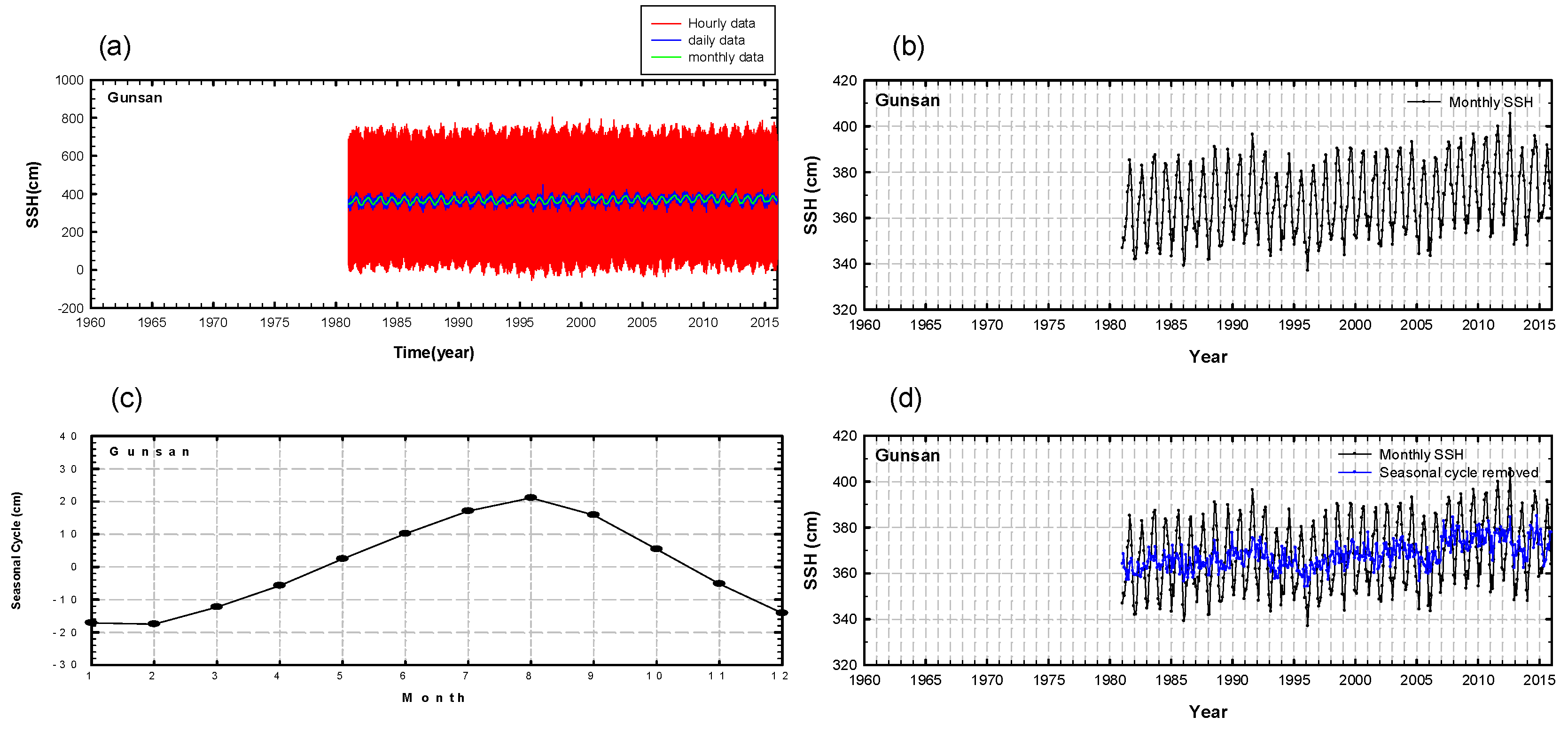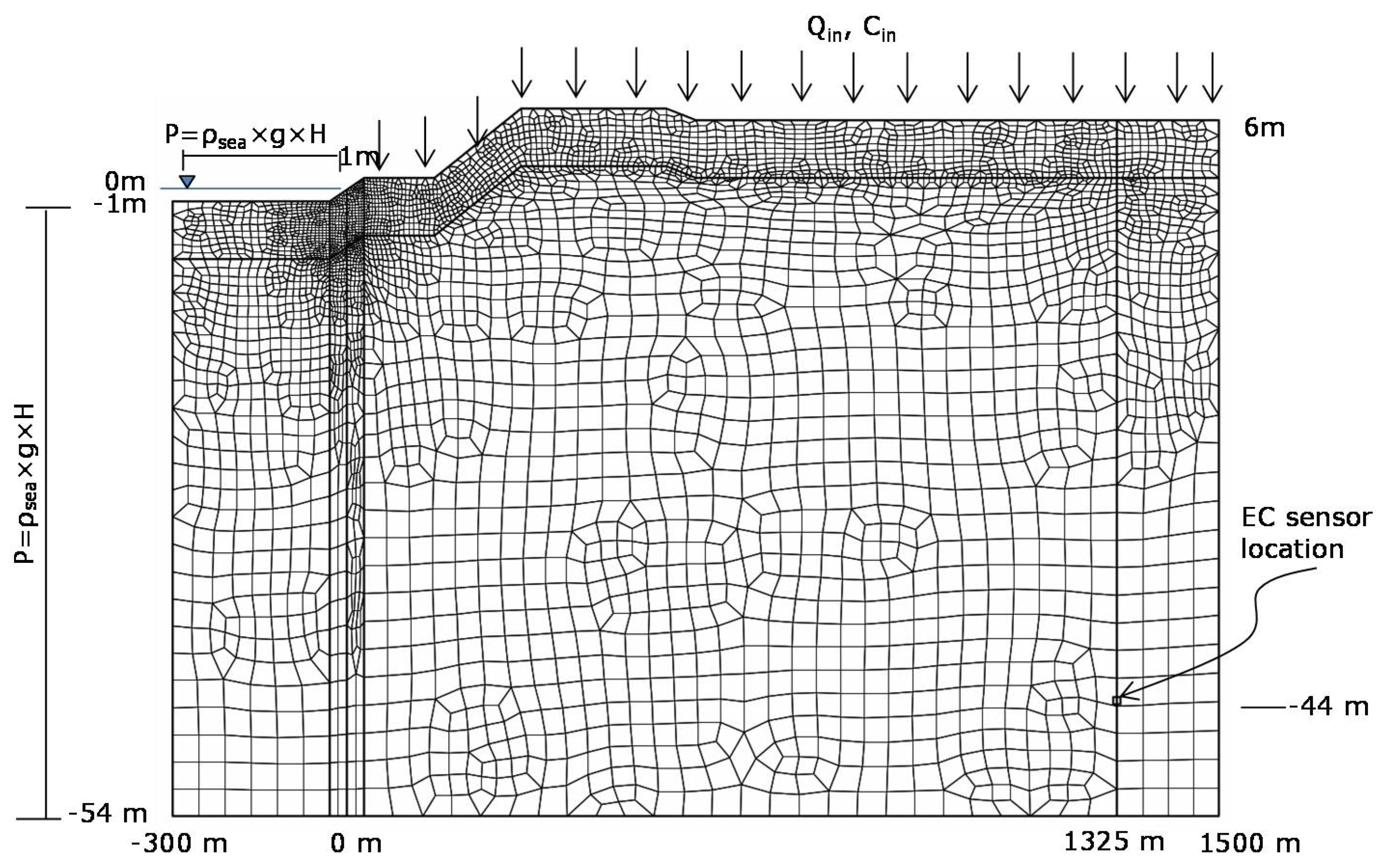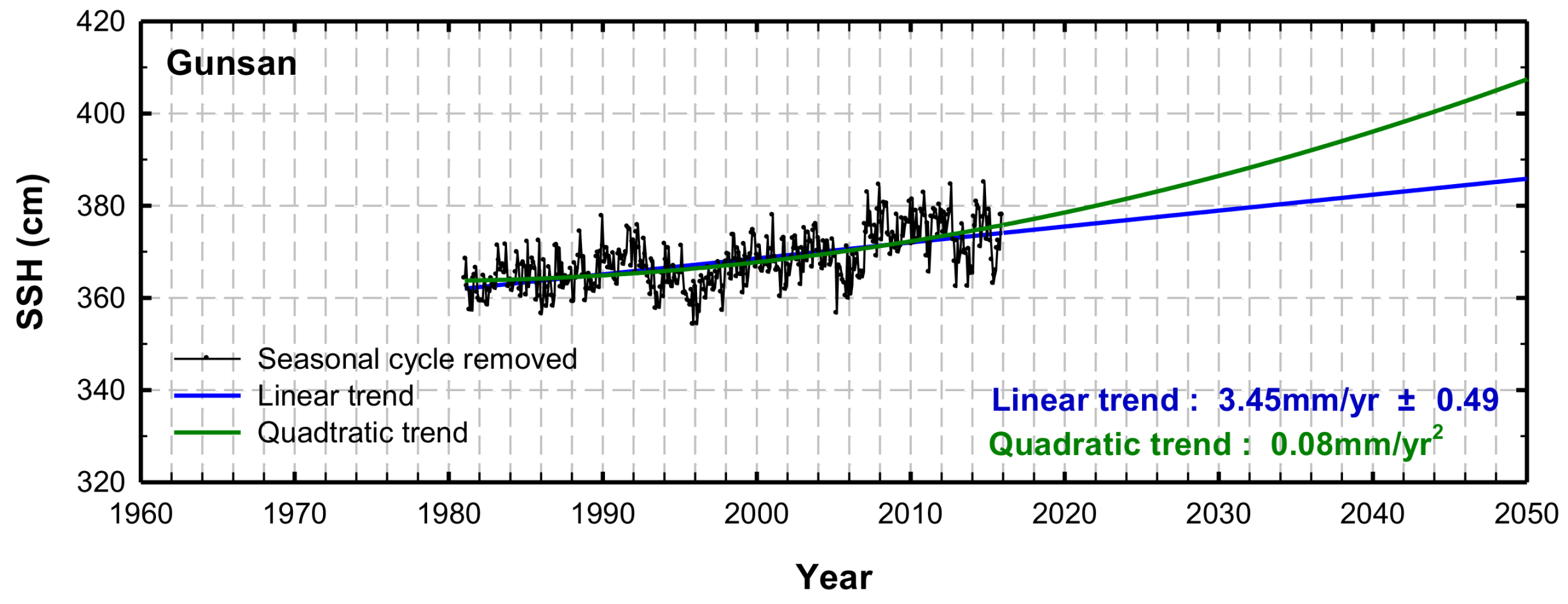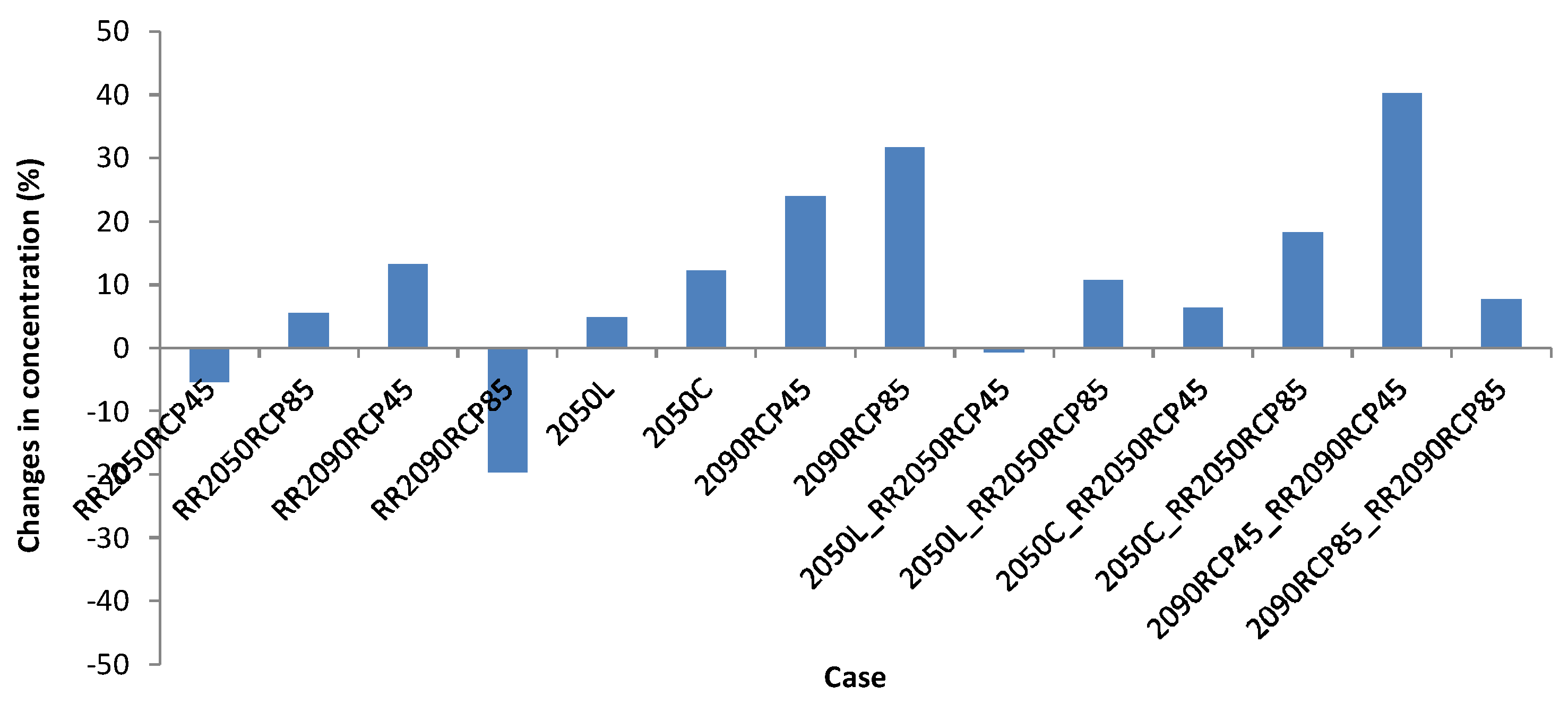Assessing Impacts of Climate Change and Sea-Level Rise on Seawater Intrusion in a Coastal Aquifer
Abstract
:1. Introduction
2. Materials and Methods
2.1. Site Description and Data Collection
2.2. Sea-Level Rise Projection
2.3. Seawater Intrusion Modeling
3. Results and Discussion
3.1. Sea-Level Rise Projection
3.2. Seawater Intrusion Modeling
4. Conclusions
Acknowledgments
Author Contributions
Conflicts of Interest
References
- Intergovernmental Panel on Climate Change (IPCC). 2013: Summary for Policymakers. In Climate Change 2013: The Physical Science Basis. Contribution of Working Group I to the Fifth Assessment Report of the Intergovernmental Panel on Climate Change; Stocker, T.F., Qin, D., Plattner, G.-K., Tignor, M., Allen, S.K., Boschung, J., Nauels, A., Xia, Y., Bex, V., Midgley, P.M., Eds.; Cambridge University Press: Cambridge, UK; New York, NY, USA, 2013. [Google Scholar]
- National Institute of Malaria Research (NIMR). Global Climate Change Report 2012; Publication number 11-1360395-000341-10; National Institute of Meteorological Research: Seogwipo, Korea, 2012. (In Korean) [Google Scholar]
- Boon, J.D.; Brubaker, J.M.; Forrest, D.R. Chesapeake bay land subsidence and sea level change: An evaluation of past and present trends and future outlook. Spec. Rep. Appl. Mar. Sci. Ocean Eng. 2010, 425, 1–73. [Google Scholar]
- Breaker, L.C.; Ruzmaikin, A. Estimating rates of acceleration based on the 157-Year record of sea level from San Francisco, California, U.S.A. J. Coast. Res. 2013, 29, 43–51. [Google Scholar] [CrossRef]
- Ezer, T.; Corlett, W.B. Is sea level rise accelerating in the Chesapeake Bay? A demonstration of a novel new approach for analyzing sea level data. Geophys. Res. Lett. 2012, 39. [Google Scholar] [CrossRef]
- Huang, N.E.; Shen, Z.; Long, S.R.; Wu, M.C.; Shih, E.H.; Zheng, Q.; Tung, C.C.; Liu, H.H. The empirical mode decomposition and the Hilbert spectrum for non stationary time series analysis. Proc. R. Soc. Lond. 1998, 454, 903–995. [Google Scholar] [CrossRef]
- Kim, Y.; Cho, K. Sea level rise around Korea: Analysis of tide gauge station data with the ensemble empirical mode decomposition method. J. Hydro-Environ. Res. 2016, 11, 138–145. [Google Scholar] [CrossRef]
- Yoon, J.J. Analysis of long-period sea-level variation around the Korean Peninsula. J. Coast. Res. 2016, 75 (Suppl. 1), 1432–1436. [Google Scholar] [CrossRef]
- Johnson, T. Battling Seawater Intrusion in the Central & West Coast Basins. WRD Tech. Bull. 2007, 13, 1–2. [Google Scholar]
- Johnson, T.A.; Whitaker, R. Saltwater Intrusion in the Coastal Aquifers of Los Angeles County, California. In Coastal Aquifer Management; Cheng, A.H., Ouazar, D., Eds.; Lewis Publishers: Boca Raton, FL, USA, 2004; Chapter 2; pp. 29–48. [Google Scholar]
- Guvanasen, V.; Wade, S.C.; Barcelo, M.D. Simulation of regional groundwater flow and saltwater intrusion in Hernando county, Florida. Groundwater 2000, 38, 772–783. [Google Scholar] [CrossRef]
- Kentel, E.; Gill, H.; Aral, M.M. Evaluation of Groundwater Resources Potential of Savannah Georgia Region; Report No. MESL-01-05; Multimedia Environmental Simulations Laboratory, School of Civil and Environmental Engineering, Georgia Institute of Technology: Atlanta, GA, USA, 2005. [Google Scholar]
- Custodio, E. Coastal aquifers of Europe: An overview. Hydrogeol. J. 2010, 18, 269–280. [Google Scholar] [CrossRef]
- Werner, A.D.; Gallagher, M.R. Characterisation of seawater intrusion in the Pioneer Valley, Australia using hydrochemistry and three-dimensional numerical modelling. Hydrogeol. J. 2006, 14, 1452–1469. [Google Scholar] [CrossRef]
- Cheng, J.M.; Chen, C.X. Three-dimensional modeling of density dependent saltwater intrusion in multilayered coastal aquifers in Jahe River basin, Shandong province, China. Groundwater 2001, 39, 137–143. [Google Scholar] [CrossRef]
- Bobba, A.G. Numerical modelling of salt-water intrusion due to human activities and sea-level change in the Godavari Delta, India. Hydrol. Sci. 2002, 47, S67–S80. [Google Scholar] [CrossRef]
- Datta, B.; Chakraborthy, D.; Dhar, A. Simultaneous identification of unknown groundwater pollution sources and estimation of aquifer parameters. J. Hydrol. 2009, 376, 48–57. [Google Scholar] [CrossRef]
- Rouve, G.; Stoessinger, W. Simulation of the Transient Position of the Saltwater Intrusion in the Coastal Aquifer near Madras Coast. In Proceedings of the 3rd International Conference on Finite Elements in Water Resources, Oxford, MS, USA, 19–23 May 1980. [Google Scholar]
- Sherif, M.M.; Singh, V.P.; Amer, A.M. A two e dimensional finite element model for dispersion (2D-FED) in coastal aquifer. J. Hydrol. 1988, 103, 11–36. [Google Scholar] [CrossRef]
- Nobi, N.; Gupta, A.D. Simulation of regional flow and salinity intrusion in an integrated stream aquifer system in a coastal region: Southwest region of Bangladesh. Groundwater 1997, 35, 786–796. [Google Scholar] [CrossRef]
- Chang, S.W. A review of recent research into coastal groundwater problems and associated case studies. J. Eng. Geol. 2014, 24, 597–608, (In Korean with English Abstract). [Google Scholar] [CrossRef]
- Kim, N.W.; Chung, I.M.; Yoo, S.; Lee, J.; Yang, S.K. Integrated surface-groundwater analysis in Jeju Island. J. Environ. Sci. 2009, 18, 1017–1026, (In Korean with English Abstract). [Google Scholar] [CrossRef]
- Werner, A.D.; Simmons, C.T. Impact of sea-level rise on sea water intrusion in coastal aquifers. Groundwater 2009, 47, 197–204. [Google Scholar] [CrossRef] [PubMed]
- Pool, M.; Carrera, J. Dynamics of negative hydraulic barriers to prevent seawater intrusion. Hydrogeol. J. 2010, 18, 95–105. [Google Scholar] [CrossRef]
- Jung, E.T.; Lee, S.J.; Lee, M.J.; Park, N. Effectiveness of double negative barriers for mitigation of seawater intrusion in coastal aquifer: Sharp-interface modeling investigation. J. Korea Water Resour. Assoc. 2014, 47, 1087–1094, (In Korean and English Abstract). [Google Scholar] [CrossRef]
- Kalaoun, O.; Bitar, A.A.; Castellu-Etchegorry, J.-P.; Jazar, M. Impact of demographic growth on seawater intrusion: Case of the Tripoli Aquifer, Lebanon. Water 2016, 8, 104. [Google Scholar] [CrossRef]
- Rasmussen, P.; Sonnenborg, T.O.; Goncear, G.; Hinsby, K. Assessing impacts of climate change, sea level rise, and drainage canals on saltwater intrusion to coastal aquifer. Hydrol. Earth Syst. Sci. 2013, 17, 421–443. [Google Scholar] [CrossRef]
- Voss, C.I. SUTRA: A Finite Element Simulation Model for Saturated-Unsaturated, Fluid-Density Dependent Groundwater Flow with Energy Transport or Chemically Reactive Single-Species Solute Transport; Report 02-4231; US Geological Survey, Water Resources Investigations: Reston, VA, USA, 1984.
- Narayan, K.A.; Schleeberger, C.; Bristow, K.L. Modelling seawater intrusion in the Burdekin Delta Irrigation Area, North Queensland, Australia. Agric. Water Manag. 2007, 89, 217–228. [Google Scholar] [CrossRef]
- Hussain, M.S.; Javadi, A.A.; Sherif, M.M. Three dimensional simulation of seawater intrusion in a regional coastal aquifer in UAE. Procedia Eng. 2015, 119, 1153–1160. [Google Scholar] [CrossRef] [Green Version]
- Ghassemi, F.; Chen, T.H.; Jakeman, A.J.; Jacobson, G. Two and three-dimensional simulation of seawater intrusion: Prefermances of the “SUTRA” and “HST3D” models. AGSO J. Aust. Geol. Geophys. 1993, 14, 219–226. [Google Scholar]
- Lee, B.S.; Kim, Y.I.; Choi, K.-J.; Song, S.-H.; Kim, J.H.; Woo, D.K.; Seol, M.K.; Park, K.Y. Rural Groundwater Monitoring Network in Korea. J. Soil Groundw. Environ. 2014, 19, 1–11, (In Korean with English Abstract). [Google Scholar] [CrossRef]
- Lee, J.-Y.; Kwon, K.D. Current status of groundwater monitoring networks in Korea. Water 2016, 8, 168. [Google Scholar] [CrossRef]
- Piper, A.M. A graphic procedure I the geo-chemical interpretation of water-analyses. Eos Trans. Am. Geophys. Union 1953, 25, 914–928. [Google Scholar] [CrossRef]
- Kim, M.-K.; Lee, D.-H.; Kim, J. Production and validation of daily grid data with 1 km resolution in South Korea. J. Clim. Res. 2013, 1, 13–25, (In Korean with English Abstract). [Google Scholar]
- Bell, C.; Vassie, J.M.; Woodworth, P.L. POL/PSMSL Tidal Analysis Software Kit 2000 (Task-2000); Permanent Service for Mean Sea Level, CCMS Proudman Oceanographic Laboratory, Bidston Observatory, Birkenhead: Merseyside, UK, 1999; p. 20. [Google Scholar]
- Murray, M.T. A general method for the analysis of hourly of the tide. Int. Hydrogr. Rev. 1964, 41, 91–101. [Google Scholar]
- Voss, C.I.; Provost, A.M. SUTRA, a Model for Saturated–Unsaturated, Variable-Density Ground-Water Flow with Solute or Energy Transport; Water-Resources Investigations Report 2002 02-4231; U.S. Department of the Interior, USGS: Reston, VA, USA, 2002.
- Winston, R.B. ModelMuse-A Graphical User Interface for MODFLOW-2005 and PHAST; Techniques and Methods 6-A29; U.S. Department of the Interior, USGS: Reston, VA, USA, 2009.
- Harbaugh, A.W. MODFLOW-2005, the U.S. Geological Survey Modular Ground-Water Model-the Ground-Water Flow Process; U.S. Geological Survey Techniques and Methods 6-A16; U.S. Department of the Interior, USGS: Reston, VA, USA, 2005.
- Shoemaker, W.B.; Kuniansky, E.L.; Birk, S.; Bauer, S.; Swain, E.D. Documentation of a Conduit Flow Process (CFP) for MODFLOW-2005; Techniques and Method 6-A24; USGS: Reston, VA, USA, 2007.
- Parkhurst, D.L.; Kipp, K.L.; Engesgaard, P.; Charlton, S.R. PHAST—A Program for Simulating Ground-Water Flow, Solute Transport, and Multicomponent Geochemical Reactions; U.S. Geological Survey Techniques and Methods 6-A8; USGS: Reston, VA, USA, 2004; 154p.
- Nerem, R.S.; Chambers, D.; Choe, C.; Mitchum, G.T. Estimating Mean Sea Level Change from the TOPEX and Jason Altimeter Missions. Mar. Geod. 2010, 33, 435–446. [Google Scholar] [CrossRef]
- Chung, I.-M.; Kim, J.; Lee, J.; Chang, S.W. Status of exploitable groundwater estimation in Korea. J. Eng. Geol. 2015, 25, 403–412. [Google Scholar] [CrossRef]
- Lee, C.-H.; Chen, W.-P.; Lee, R.-H. Estimation of groundwater recharge using water balance coupled with base-flow-record estimation and stable-bae-flow analysis. Environ. Geol. 2006, 51, 73–82. [Google Scholar] [CrossRef]
- Anderson, M.P. Using models to simulate the movement of contaminants through groundwater flow systems. Crit. Rev. Environ. Control 1979, 9, 97–156. [Google Scholar] [CrossRef]
- Gelhar, L.W.; Welty, C.; Rehfeldt, K.R. A critical review of data on field-scale dispersion in aquifers. Water Resour. Res. 1992, 28, 1955–1974. [Google Scholar] [CrossRef]






| Cases | SLR (m) | Freshwater Recharge Rate (kg s−1) | Descriptions |
|---|---|---|---|
| Baseline | 0.0 | 0.00603 | 2005–2015 |
| RR2050RCP45 | 0.0 | 0.00627 | 2050s, RCP4.5, Precipitation (1) |
| RR2050RCP85 | 0.0 | 0.00580 | 2050s, RCP8.5, Precipitation (2) |
| RR2090RCP45 | 0.0 | 0.00549 | 2090s, RCP4.5, Precipitation (3) |
| RR2090RCP85 | 0.0 | 0.00694 | 2090s, RCP8.5, Precipitation (4) |
| 2050L | 0.12 | 0.00603 | Linear trend by 2050 (5) |
| 2050C | 0.32 | 0.00603 | Quadratic trend by 2050 (6) |
| 2090RCP45 | 0.57 | 0.00603 | SLR of the West sea under RCP4.5 (7) |
| 2090RCP85 | 0.72 | 0.00603 | SLR of the West sea under RCP8.5 (8) |
| 2050L_RR2050RCP45 | 0.12 | 0.00627 | (1) and (5) |
| 2050L_RR2050RCP85 | 0.12 | 0.00580 | (2) and (5) |
| 2050C_RR2050RCP45 | 0.32 | 0.00627 | (1) and (6) |
| 2050C_RR2050RCP85 | 0.32 | 0.00580 | (2) and (7) |
| 2090RCP45_RR2090RCP45 | 0.57 | 0.00549 | (3) and (7) |
| 2090RCP85_RR2090RCP85 | 0.72 | 0.00694 | (4) and (8) |
© 2018 by the authors. Licensee MDPI, Basel, Switzerland. This article is an open access article distributed under the terms and conditions of the Creative Commons Attribution (CC BY) license (http://creativecommons.org/licenses/by/4.0/).
Share and Cite
Chun, J.A.; Lim, C.; Kim, D.; Kim, J.S. Assessing Impacts of Climate Change and Sea-Level Rise on Seawater Intrusion in a Coastal Aquifer. Water 2018, 10, 357. https://doi.org/10.3390/w10040357
Chun JA, Lim C, Kim D, Kim JS. Assessing Impacts of Climate Change and Sea-Level Rise on Seawater Intrusion in a Coastal Aquifer. Water. 2018; 10(4):357. https://doi.org/10.3390/w10040357
Chicago/Turabian StyleChun, Jong Ahn, Changmook Lim, Daeha Kim, and Jin Sung Kim. 2018. "Assessing Impacts of Climate Change and Sea-Level Rise on Seawater Intrusion in a Coastal Aquifer" Water 10, no. 4: 357. https://doi.org/10.3390/w10040357





